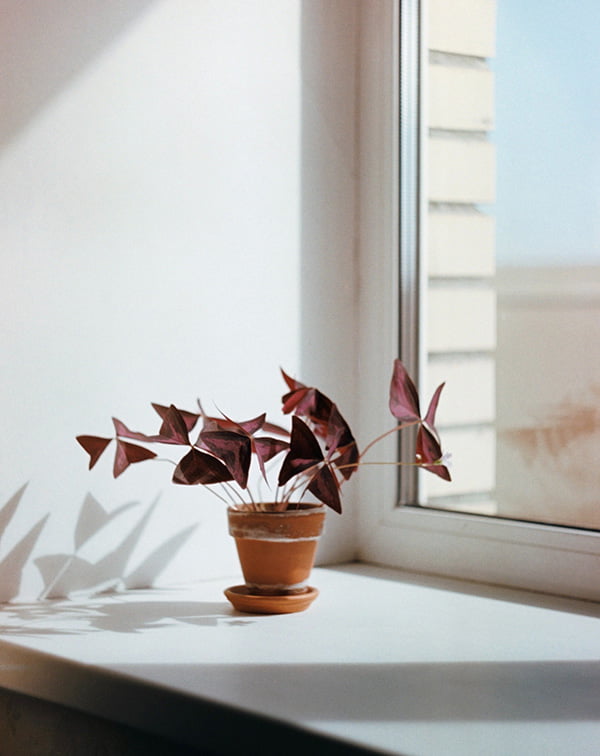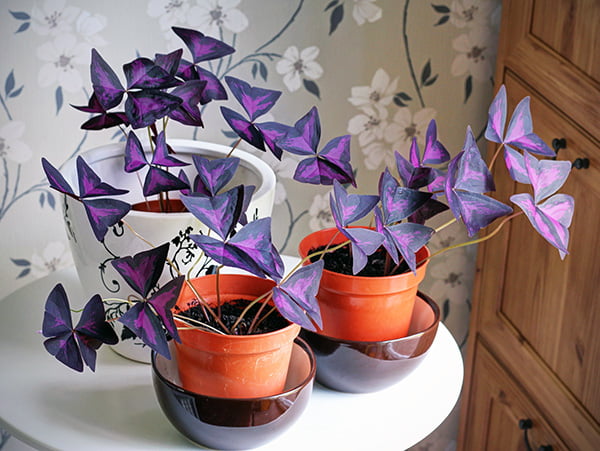Oxalis Triangularis has incredible, deep purple leaves and small, pale flowers. This stunning combination has many people turning their annuals into year-round houseplants, with good reason! If cared for well, these plants can live for over a hundred years! They're the perfect heirloom plants.
Below, we'll discuss everything you'll need to know to grow a densely packed pot of purple shamrocks!
Botanical Name
Common Name
Plant Type
Mature Size
Sun Requirement
Soil Type
Hardiness Zone
Pet Friendly
Oxalis Triangularis
False shamrock
Perennial
6-12 in. tall (15-30 cm) and 12-24 in w
Bright light
Well drained
8a–11
No
What Are Oxalis Triangularis?
Although it's often nicknamed "false shamrock," Oxalis Triangularis is actually in the wood sorrel family, not the clover family. The foliage is the main attraction, and the leaves actually consist of three separate leaflets that are deeply colored. Both green and purple varieties are available, with the purple one often labeled as "purple shamrocks."
They will bloom small trumpet-shaped flowers. The purple shamrock tends to produce purple and pink flowers, while the green variety will have yellow and white flowers.
Both leaves and flowers are photonastic, meaning they will close at night and open again during the day!

Source: Pexels
Oxalis Triangularis Care Requirements
Light
It's important that you give your Oxalis Triangularis plant enough light. At least half a day of direct sunlight is preferred. While your plant will still grow if only provided with indirect light, it will get leggy and not be as full. If you can, stick it right in front of a west-facing window. Depending on where you live, the morning light levels might not be strong enough for your purple shamrock plant to thrive, even in an east-facing window. Lots of bright light is key!
Water
Water your purple shamrock plant when the top two inches of the soil are dry. If your plant is getting ample sunlight, this could be pretty frequent! When it's time to water, drench the soil thoroughly! Take it to the sink and water it until the excess runs out of the pot's drainage hole. Let it sit for ten minutes to give the water time to drain, then place it back in its spot.
Temperature
False shamrock is native to South America, so it doesn't handle freezes well. This is why it's commonly sold as an annual, but if you live in USDA Hardiness Zones 6 through 11, it can be grown outdoors as a perennial. Still, although Oxalis doesn't like freezing temperatures, it does like things to be moderately chilly. Temperatures between 60 and 75 degrees Fahrenheit are ideal. Too low will kill it, and too high will cause the plant to enter a dormancy period.
Soil
Well-draining potting mix is a must. Oxalis Triangularis doesn't like overly wet soil, but it does like moist soil. To achieve adequate drainage, plant your Oxalis Triangularis in soil made of 3 parts standard potting mix and 1 part perlite. And always use a pot with a drainage hole!
Fertilization
You can add diluted liquid fertilizer to each normal watering during the growing season.
Propagation
Because Oxalis Triangularis grows from a tuber, dormancy is the time to propagate your plant if you're going to do it! Dig up the tuber and divide it. You will likely see natural divisions to cut along.
Pruning
Pruning of the Oxalis Triangularis plant is low to none as the plant will go into dormancy during winter. To get a better quality of leaves in the springtime, consider a hard-prune by cutting back the foliage to the soil line.

Source: Flickr
Dormancy Period
If you're doing everything right but you notice the leaves starting to shrivel and dry up, don't worry! It's completely normal! Oxalis Triangularis grow from tubers, not roots, and so they will periodically go into dormancy. Young plants will have a dormant period after every growing season, and mature plants will go dormant every few years.
Allow the plant to die back, clear away the dead foliage, then place the pot in a cooler, darker area for a month or two. Don't water or fertilize it! Afterward, place it back in its full sun location and start to lightly water it, keeping it drier than normal for a few weeks. New growth will come back quickly and vigorously!
Common Problems With Oxalis Triangularis
Common Diseases
Oxalis Triangularis can come down with root rot and powdery mildew as indoor plants.
Root Rot
Root rot shows itself in yellowing, wilting leaves. It's caused by overwatering, and simply letting the soil dry out won't fix it - you've got rotten roots. Unpot the plant, let the roots dry, cut away any that are dead, then repot it in fresh soil.
Powdery Mildew
Powdery mildew appears as white patches on your leaves. You might notice it if there hasn't been much sunlight, high humidity levels, and chilly temperatures. It's more a problem for plants kept outdoors when the weather has been rainy and overcast for days. Use a fungicide to treat.
Common Pests
You'll most likely encounter three pests: spider mites, mealy bugs, and thrips.
Spider mites are almost too small to be seen, but you'll notice a fine webbing on the affected leaves.
Mealybugs are easily spotted, and they look like white flecks of fluff. Insecticidal soap or neem oil can be used to treat both mealybugs and spider mites.
Thrips can be devilishly hard to treat, and the best course of action is to isolate your purple shamrock plant, push it into dormancy by not watering it, and treat the soil with an insecticide.
Is Oxalis Triangularis Pet Friendly?
Oxalis Triangularis is toxic to both cats and dogs because of its calcium oxalate content. In rare cases, these oxalates cause excess salivation, tremors, and even kidney failure. For humans (and children), it is an edible plant - although only in small amounts, as the oxalic acid makes it incredibly sour.

